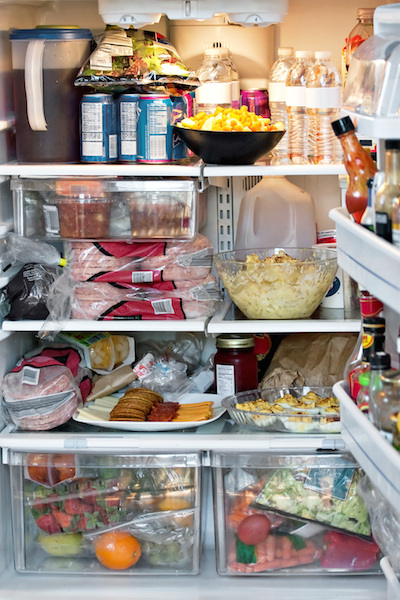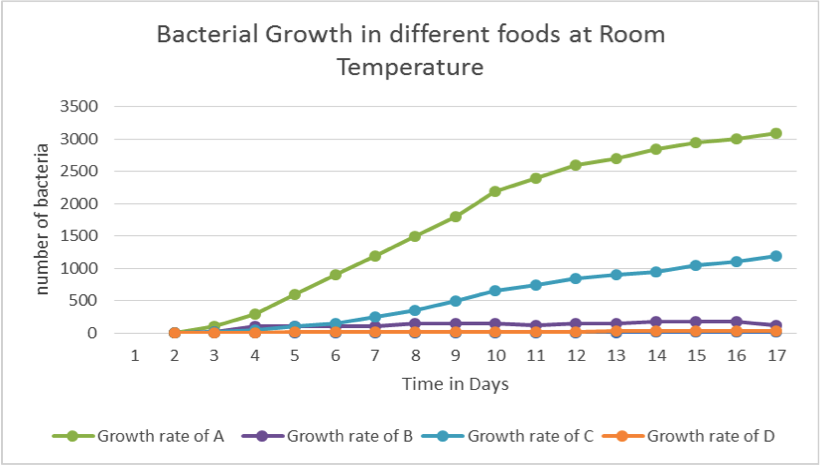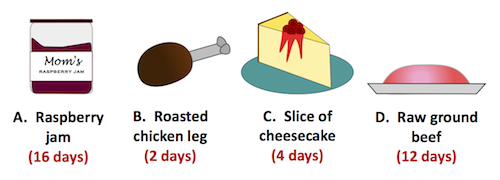
Chapter 13. The Oldest Thing in Your Fridge
The Oldest Thing in Your Fridge


Read the article below. Then answer the questions that follow.
Is that safe to eat that?
How long do you leave food in your refrigerator? A couple of days? A week? Until it turns blue and fuzzy? Or, until it walks out of the fridge by itself? Knowing about osmosis will help you understand why old Chinese takeout should be tossed, wheras the jelly left by your roommate last year might actually be edible.
A cold refrigerator will help slow the growth of microbes on our food. But even if you keep your leftovers cold, sooner or later fungi and bacteria will start growing, and the food will spoil. Yet foods that have a lot of sugar and salt last longer than others. This is because the process of osmosis works in their favor.
Osmosis helps out your fridge’s old timers
Think about some of the things that have been in your fridge for a long time. Typical long-term residents in a fridge include pickles, mustard, ketchup, salad dressing, and jelly. Let’s see how osmotic pressure works in your refrigerator, starting with a jar of jelly. When did you first open it? One month ago, or was it six? Is it still safe to eat? Yes. Jelly has far more sugar in it than bacteria. This means it’s a hypertonic environment.
As bacteria have semi-permeable membranes, water moves from the less concentrated solution inside the cell towards the higher sugar concentration in the jelly. This process of osmosis kills the bacteria, which are often 90 percent water.
Osmotic pressure forms when concentrations outside the cell are different than the solution inside the cell membrane. Hypothetically speaking, this pressure would go away if the water flowing out of the bacteria diluted the sugar—once the concentrations equalized, osmosis would stop. Of course there is far too much sugar in the jelly jar, and not enough water inside the bacteria, for equilibrium to ever be reached.
While the sugar in jelly sucks the life out of most bacteria, you might find a few bacteria and fungi that manage to survive in hypertonic environments. However, even these hardy microbes can’t grow quickly. Osmotic pressure makes jelly a bad environment for bacteria.
Can you think of other foods that last a long time due to high osmotic pressure–even outside of the refrigerator?
Salt causes osmotic pressure too

Ever notice that many restaurants leave ketchup on the table? Take a look at the label on a typical bottle: 17 grams (1 tablespoon) of ketchup contains 4 grams of sugar and 190 milligrams of sodium, or salt.
Salt depends on osmosis to preserve food—it removes water from the bacterial cells just like the sugar in jelly. When rubbed on beef and fish, salt can also remove water from the meat by osmosis. Microbes don’t grow well in such a dry environment, which is why you don’t need to worry about salty jerky going bad for a very long time.
Most desserts are made with a lot of sugar. This increases the osmotic pressure, and the food stays safe to eat for a little longer than other leftovers. This is why desserts can be kept in the fridge for five days, but other foods are usually tossed after three days.
When in doubt, throw it out
But without sugars or salt to create a hypertonic environment, bacteria can colonize foods very quickly. This is one reason raw meat spoils easily. Even when kept in the refrigerator, raw meats should be eaten within a couple of days. Cooked meats (with denatured proteins) should be safe for about three days in the fridge.
If you are ever unsure about whether food has been in the fridge too long, it’s a good idea to toss it. Bacteria-induced food poisoning can be an extremely painful experience, as anyone who has gone through it can tell you. Measured up against the possibility of enduring a bout of food poisoning, those suspect short ribs are something you can get by without.
© 2015 WH Freeman and Company.
13.1 Comprehension Questions
Answer the following questions to demonstrate your understanding of the article.
1.
Refrigerating perishable foods the rate at which bacteria can divide.
2.
Fill in the missing words to complete this paragraph:
The process of , where water moves across a cell’s semi-permeable from an area of solute concentration to an area of solute concentration, works in favor of certain foods such as jelly, salad dressing, and mustard, which can last for a long time without spoiling.
3.
Foods like ketchup and pickles have a(n) environment that kills most bacteria.
4.
Fill in the Blank:
Commonly used as a preservative, also enhances the taste and desirability of many foods, including jams and jellies.
5.
True/False:
Canning fresh vegetables in a salt brine solution would keep them fresh and edible for a long period of time.
6.
Bacteria are almost 90 percent water. Therefore, we can surmise that bacteria cannot survive in a solution that is less than _____ percent water.
| A. |
| B. |
| C. |
| D. |
| E. |
7.
Why is it not possible to keep fruit fresh for long periods of time without the use of refrigeration or preservatives?
| A. |
| B. |
| C. |
| D. |
| E. |
8.
Why should you toss out cooked meat after three days (even if it is refrigerated)?
| A. |
| B. |
| C. |
| D. |
| E. |
9.

The graph above shows the rate of bacterial growth in four different foods, all kept at room temperature for 17 days. Based on the results, under which conditions—at room temperature, in the refrigerator, or in the freezer—would you need to store each food if you planned on keeping them fresh for at least 2 weeks? (Click the graph to expand for a closer view.)
A. Food A
B. Food B
C. Food C
D. Food D
10.
You are cleaning out your fridge. Your roommate is convinced that the four items pictured below all need to be thrown away. But it's ultimately up to you to decide which ones are still safe to eat. Based on the number of days (in red) that each has been in the fridge, which item should be thrown away immediately? Click the correct figure below to record your answer.
{"title":"A. Raspberry jam","description":"No. The jam will remain edible for many days to come. As the article points out, jams and jellies' high sugar content makes them poor environments for bacterial growth.","type":"incorrect","color":"#ffff99","code":"[{\"shape\":\"rect\",\"coords\":\"2,7,116,174\"}]"} {"title":"B. Chicken leg (cooked)","description":"No. The cooked chicken leg is probably still okay. Most cooked meat will stay fresh for up to 3 days in the fridge. ","type":"incorrect","color":"#ffff99","code":"[{\"shape\":\"rect\",\"coords\":\"123,9,234,173\"}]"} {"title":"C. Cheesecake","description":"No. The slice of cheesecake should still be safe to eat. Most sugary desserts will remain fresh in the fridge for up to 5 days.","type":"incorrect","color":"#ffff99","code":"[{\"shape\":\"rect\",\"coords\":\"239,9,358,175\"}]"} {"title":"D. Ground beef (raw)","description":"Yes. The raw ground beef is unsafe. Even though refrigeration has slowed the growth rate of bacteria, the uncooked meat likely contains unsafe levels of bacteria that could cause a nasty case of food poisoning--especially after 12 days. Throw it away!","type":"correct","color":"#ffff99","code":"[{\"shape\":\"rect\",\"coords\":\"366,10,487,174\"}]"}Activity results are being submitted...
